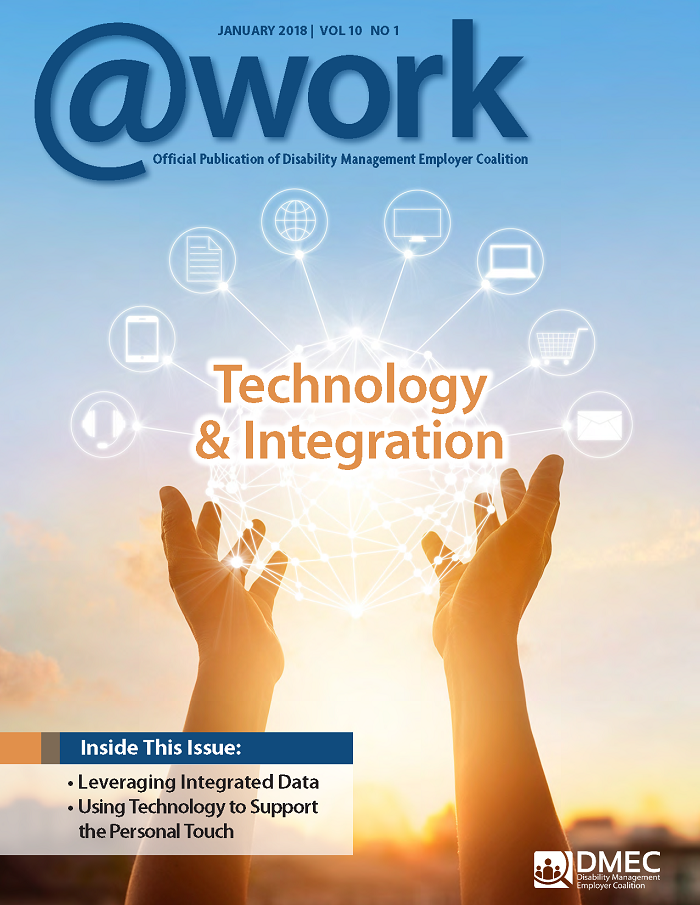
January 2018
Technology & Integration
This issue of @Work features strategies for effectively utilizing data and technology to identify key intervention points and to create opportunities for integrating personal touch when and where it is necessary for employees out on leave or returning from a leave.
Features
Holistic Clinical Prevention: Leveraging Integrated Data
Many employers receive an annual report from health plans listing high-cost claims, and find themselves wondering what they could have done to prevent such costly episodes. Fortunately, it is possible to leverage integrated data to predict which individuals are headed toward this high-risk group. Read more.

The Personal Touch: Use Technology to Support It
Integrating a leave management technology to manage complexities seems like a no-brainer. But amid increased high-tech processes, employers must not forget to stay high-touch when needed — such as during the interactive accommodation process. Read more.

Spotlight Articles
Program Showcase: Employee Responsibility
When Clark County decided to take leave reporting responsibility away from supervisors and put it on the employees, it needed to provide the capability for 24-hour absence and tardy reporting. The only efficient process was to literally put the solution in the palm of employees’ hands. Read more.

RTW Resources: Accessible Technology
When technology doesn’t work for everyone, including people with disabilities, technology goes from being a “great equalizer” to a tool of exclusion, creating barriers to employment and preventing the career advancement of certain individuals. Read more.

Compliance Makeover: Information Security Risks
The rapidly changing technology landscape in the world of integrated absence management and the growing number of systems we use on a daily basis have expanded the risk for all of us. Read more.

Columns
Work/Life Squeeze: Caregiver Protections
Many employers don’t realize the extent of job protections for employees with family responsibilities. But with many employees in the “Sandwich Generation,” job protections for family caregivers are quickly becoming more important. Read more.

Integrated Absence Management: Reducing Employee Financial Stress
A recent survey shows that employees spend five to 13 hours per month worrying about their personal finances while at work. For employers, this translates into a nearly $250 billion loss in healthcare, productivity, and lost wages every year. Read more.

Absence Matters: Whole Health Solutions
Employees have high expectations for convenient service, and employers want to reduce their administrative burdens. A “whole health” solution — offering a single resource for all benefits-related questions and needs — can achieve both goals. Read more.

The Disabled Workforce: Fitness-for-Duty Examinations
Simply put, a fitness-for-duty examination is a tool to use when you are stuck. This can be when a case is not progressing toward return to work, involves multiple comorbid conditions, or even when it appears to be a “simple” case. Read more.

Innovations Enhance Outcomes: Building Digital Connections
With the latest smartphone, the average person can book an airplane seat, cash a check, pay bills, check the weather, and stream a movie. So why is the healthcare and disability world so far behind? Read more.

Accommodations Best Practice Guide: Resources for an Easier Process
When faced with an accommodation request, high- or low-tech, you want to engage employees in a discussion about the limitations they are experiencing and get their input on possible solutions. Read more.

Riding the Demographic Wave: Multigenerational Workforce
For the first time in our country’s history, four different generations are in the workplace. One-size-fits-all health and productivity solutions are quickly becoming passé as the different generations bring their own perspective and expectations about work. Read more.

The Future of Leave Management: 18F
Efforts are underway to raise awareness and support more open, coordinated, and integrated technology infrastructures to support paid family and medical leave legislation. One such effort has been spearheaded by the U.S. Department of Labor and 18F. Read more.

6 Pillars of Leave Management: Extracting Data
Are you thinking about switching from managing leave manually to using a software system or outsourcing to a vendor? A common concern in this situation is how you can pull the data you need from your various human resource systems. Read more.

Aligning Workers’ Compensation: Decision Support Systems
Decision support systems (DSSs) are proliferating in underwriting and the handling of property and casualty claims. Does DSS technology have a role to play in nonoccupational disability for absence managers? Read more.

Departments
The CEO’s Desk: The Yin and Yang of Technology
Artificial Intelligence is embedded in our lives, whether we like it or not. So, it makes sense that it has made its way into absence management as well. Rather than viewing this as a threat, the human-computer collaboration is evolving into a high-touch/high-tech partnership. Read more.

DMEC News: January 2018
In this issue of DMEC News, we recognize new and departing EAC members, reflect on retiring DMEC Board Treasurer Joe Wozniak’s contribution, and welcome new sponsors for 2018. Read more.

Compliance Memos: January 2018
The January 2018 compliance memos cover IRS employer mandate penalty letters, IRS guidance on withholding systems, the 7th Circuit’s leave-as-an-accommodation ruling, Washington’s paid sick leave law, and recent NLRB rulings. Read more.




